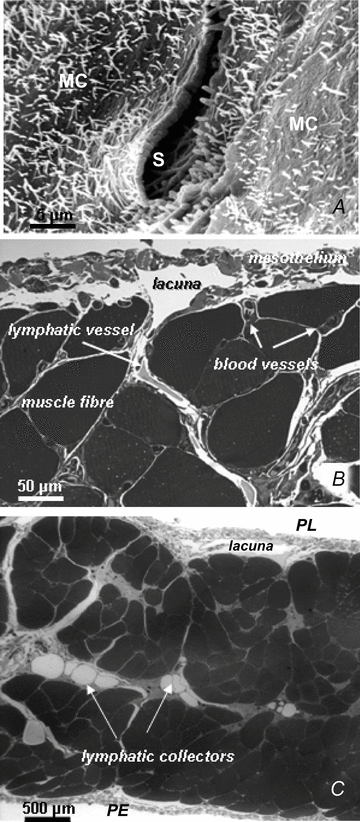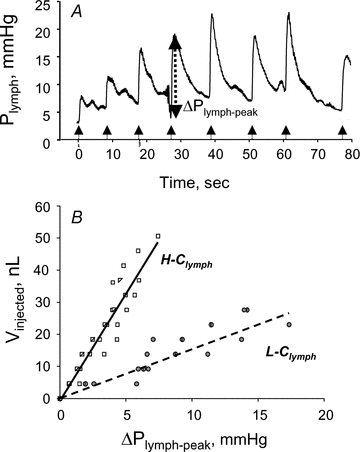Lymphatic anatomy and biomechanics
- PMID: 21486777
- PMCID: PMC3139076
- DOI: 10.1113/jphysiol.2011.206672
Lymphatic anatomy and biomechanics
Abstract
Lymph formation is driven by hydraulic pressure gradients developing between the interstitial tissue and the lumen of initial lymphatics. While in vessels equipped with lymphatic smooth muscle cells these gradients are determined by well-synchronized spontaneous contractions of vessel segments, initial lymphatics devoid of smooth muscles rely on tissue motion to form lymph and propel it along the network. Lymphatics supplying highly moving tissues, such as skeletal muscle, diaphragm or thoracic tissues, undergo cyclic compression and expansion of their lumen imposed by local stresses arising in the tissue as a consequence of cardiac and respiratory activities. Active muscle contraction and not passive tissue displacement is required to support an efficient lymphatic drainage, as suggested by the fact that the respiratory activity promotes lymph formation during spontaneous, but not mechanical ventilation. The mechanical properties of the lymphatic wall and of the surrounding tissue also play an important role in lymphatic function. Modelling of stress distribution in the lymphatic wall suggests that compliant vessels behave as reservoirs accommodating absorbed interstitial fluid, while lymphatics with stiffer walls, taking advantage of a more efficient transmission of tissue stresses to the lymphatic lumen, propel fluid through the lumen of the lymphatic circuit.
Figures






Similar articles
-
Tissue contribution to the mechanical features of diaphragmatic initial lymphatics.J Physiol. 2010 Oct 15;588(Pt 20):3957-69. doi: 10.1113/jphysiol.2010.196204. J Physiol. 2010. PMID: 20724369 Free PMC article.
-
Microlymphatics and lymph flow.Physiol Rev. 1990 Oct;70(4):987-1028. doi: 10.1152/physrev.1990.70.4.987. Physiol Rev. 1990. PMID: 2217560 Review.
-
Mechanisms causing initial lymphatics to expand and compress to promote lymph flow.Arch Histol Cytol. 1990;53 Suppl:107-14. doi: 10.1679/aohc.53.suppl_107. Arch Histol Cytol. 1990. PMID: 2252623 Review.
-
Mechanical forces and lymphatic transport.Microvasc Res. 2014 Nov;96:46-54. doi: 10.1016/j.mvr.2014.07.013. Epub 2014 Aug 5. Microvasc Res. 2014. PMID: 25107458 Free PMC article. Review.
-
Lymphatic vessels of the eye - old questions - new insights.Ann Anat. 2019 Jan;221:1-16. doi: 10.1016/j.aanat.2018.08.004. Epub 2018 Sep 18. Ann Anat. 2019. PMID: 30240907 Review.
Cited by
-
Fluid Osmolarity Acutely and Differentially Modulates Lymphatic Vessels Intrinsic Contractions and Lymph Flow.Front Physiol. 2018 Jul 5;9:871. doi: 10.3389/fphys.2018.00871. eCollection 2018. Front Physiol. 2018. PMID: 30026707 Free PMC article.
-
Meaning of the Solid and Liquid Fascia to Reconsider the Model of Biotensegrity.Cureus. 2018 Jul 5;10(7):e2922. doi: 10.7759/cureus.2922. Cureus. 2018. PMID: 30197845 Free PMC article. Review.
-
Networks of Nerve Fibers, and Blood and Lymphatic Vessels in the Mouse Auricle: The Structural Basis of Ear Acupuncture.Med Acupunct. 2024 Apr 1;36(2):79-86. doi: 10.1089/acu.2023.0077. Epub 2024 Apr 11. Med Acupunct. 2024. PMID: 38659726 Free PMC article.
-
Anatomical, physiological, and experimental factors affecting the bioavailability of sc-administered large biotherapeutics.J Pharm Sci. 2015 Feb;104(2):301-6. doi: 10.1002/jps.24277. Epub 2014 Nov 19. J Pharm Sci. 2015. PMID: 25411114 Free PMC article.
-
Nano-fluorescence imaging: advancing lymphatic disease diagnosis and monitoring.Nano Converg. 2024 Dec 11;11(1):53. doi: 10.1186/s40580-024-00462-1. Nano Converg. 2024. PMID: 39661218 Free PMC article. Review.
References
-
- Aukland K, Reed R. Interstitial–lymphatic mechanisms in the control of extracellular fluid volume. Physiol Rev. 1993;73:1–78. - PubMed
-
- Benoit JN, Zawieja DC, Goodman AH, Granger HJ. Characterization of intact mesenteric lymphatic pump and its responsiveness to acute edemagenic stress. Am J Physiol Heart Circ Physiol. 1989;257:H2059–H2069. - PubMed
-
- Burgeson RE, Lunstrum GP, Rokosova B, Rimberg CS, Rosenbaum LM, Keene DR. The structure and function of type VII collagen. Ann N Y Acad Sci. 1990;580:32–43. - PubMed
-
- Casley-Smith JR, Florey HW. The structure of normal small lymphatics. Q J Exp Physiol Cogn Med Sci. 1961;46:101–106. - PubMed
-
- Castenholz A. Structural and functional properties of initial lymphatics in the rat tongue: scanning electron microscopic findings. Lymphology. 1987;20:112–125. - PubMed
MeSH terms
LinkOut - more resources
Full Text Sources

